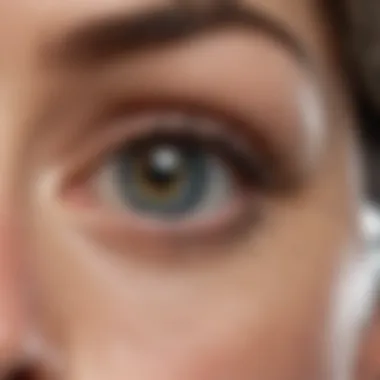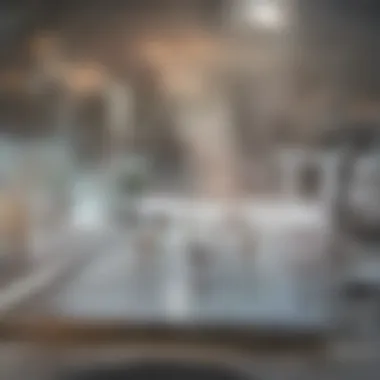Effective Strategies to Reduce Eye Pressure Naturally


Intro
Intraocular pressure (IOP) is an important marker of eye health, especially concerning conditions like glaucoma. Elevated IOP can lead to significant visual impairment and even blindness if not managed properly. Understanding the dynamics of eye pressure is crucial, not only for those who have been diagnosed with ocular conditions but also for the general population.
The management of IOP incorporates a range of strategies that span lifestyle changes, dietary adjustments, and medical treatments. These approaches are not mutually exclusive; rather, they complement each other. Therefore, this article will delve into these various strategies, emphasizing their relevance and practical applications. Consultation with healthcare professionals is necessary throughout this process.
The aim is to provide a comprehensive guide that illuminates practical steps for lowering eye pressure, thereby promoting overall ocular health.
Understanding Eye Pressure
Understanding eye pressure is essential for maintaining optical health. It lays the foundation for recognizing potential risks and managing conditions that may arise due to elevated intraocular pressure. This section will explain what intraocular pressure is and why monitoring it is crucial for individuals of all ages.
What is Intraocular Pressure?
Intraocular pressure (IOP) refers to the fluid pressure inside the eye. It plays a vital role in the overall structure and function of the eye. Normal IOP ranges from 10 to 21 mmHg. It is regulated by the balance between the production of aqueous humor—the fluid that nourishes the eye—and its drainage through the trabecular meshwork.
Elevated eye pressure can lead to serious conditions, most notably glaucoma. This disorder can damage the optic nerve, potentially resulting in vision loss. Awareness of one's intraocular pressure is crucial, as it can provide insights into ocular health risks. Regular eye exams include measuring IOP, which enables early detection and appropriate intervention if needed.
The Importance of Optical Health
Optical health is fundamental not just for vision but for overall quality of life. Maintaining eye health often extends beyond addressing vision problems. It involves understanding how factors like IOP influence eye conditions.
High IOP often goes unnoticed in its early stages, underscoring the need for regular eye examinations. A proactive approach, including appropriate lifestyle changes and medical consultation, can safeguard vision and enhance life quality. Protecting eye health is not solely focused on preventing disease but also on promoting well-being as a whole. By prioritizing eye health, individuals can ensure that their visual functions remain optimal throughout their lives.
Factors Contributing to Elevated Eye Pressure
Understanding the factors that contribute to elevated eye pressure is critical for anyone who aims to manage ocular health successfully. Intraocular pressure, if left unchecked, can lead to serious conditions such as glaucoma, which can affect vision and overall quality of life. By examining specific elements that elevate eye pressure, one can identify preventive measures and implement strategic changes that can ultimately protect eyesight.
Genetic Predispositions
Genetic influences play a significant role in eye pressure levels. Family history of eye conditions, particularly glaucoma, can heighten a person's risk. Individuals with close relatives who have suffered from elevated eye pressure should be more vigilant about regular eye exams. Genetic testing may provide further insights into inherited risks. It's essential to recognize these predispositions and actively monitor eye health as a proactive measure.
Age-Related Changes
Aging is another critical factor influencing eye pressure. As people grow older, changes in eye structure and function occur, which may lead to increased intraocular pressure. The risk of conditions such as glaucoma escalates with age. Thus, older adults must engage in frequent check-ups to detect any anomalies early. Maintaining eye health through nutrition and lifestyle choices becomes even more vital during the aging process.
Existing Medical Conditions
Certain medical conditions can significantly impact eye pressure. Understanding how these can create challenges is important for effective eye care management.
Diabetes
Diabetes is a key concern when discussing eye pressure. This condition can lead to diabetic retinopathy and further complications that impact intraocular pressure. People with diabetes often experience fluctuations in eye health, making it critical for them to manage their condition rigorously. Keeping blood sugar levels in check not only benefits overall health but also reduces the risk of eye complications. Proper diet and regular medical consultations are essential to control diabetes-related eye issues effectively.
Hypertension
Hypertension, or high blood pressure, is linked to elevated eye pressure levels. It can cause changes in the blood vessels of the eye, leading to increased intraocular pressure. Recognizing hypertension as a contributing factor to eye health is vital. Those with hypertension should actively monitor their condition and follow prescribed treatments to keep both their blood pressure and eye pressure under control. Adopting lifestyle changes, such as improved diet and regular physical activity, can also be beneficial for overall health.
Asthma
Asthma may seem unrelated to eye health at first, but it has specific implications for individuals with elevated intraocular pressure. Some asthma medications can cause eye pressure to rise as a side effect. Thus, individuals who rely on these treatments must discuss their overall health with their healthcare provider. Managing asthma effectively while being vigilant about eye health requires a collaborative approach to treatment and regular consultations.
By understanding these factors—genetic predispositions, age-related changes, and existing medical conditions—individuals can adopt a more informed approach to their eye health. Being aware of the risks allows one to take proactive steps, engage healthcare professionals, and make lifestyle adjustments that can potentially mitigate the adverse effects on eye pressure.
Lifestyle Modifications for Eye Health


Lifestyle modifications play a critical role in managing and lowering intraocular pressure, which can ultimately protect ocular health. Changes in daily habits can positively influence eye pressure, creating a holistic approach combined with medical options. Making these modifications can lead to both short-term and long-term benefits for an individual’s eye health.
Dietary Adjustments
Nutrients for Eye Health
Nutrients essential for eye health include Omega-3 fatty acids, vitamins C and E, zinc, and lutein. These nutrients contribute to overall eye wellness, helping to protect against damage from oxidative stress and reducing the risk of eye diseases. The antioxidant properties these nutrients hold are particularly important in preventing cell damage within the ocular system.
Foods to Include
Incorporating specific foods can greatly enhance eye health. Leafy greens like spinach and kale are rich in lutein, while fatty fish, such as salmon, provide Omega-3s. Citrus fruits and nuts are also beneficial. The key characteristic of these foods is their nutrient density, which plays a major role in reducing eye pressure. Eating a balanced diet filled with these options can improve blood circulation, contributing to better eye conditions.
Foods to Avoid
Certain foods can exacerbate eye pressure and overall health issues. High-sugar foods, excessive caffeine, and processed snacks should be avoided. These items can lead to increased blood sugar levels and inflammation, impacting eye health adversely. Reducing intake of these foods can have a favorable impact on overall well-being and support in maintaining optimal eye pressure levels.
Regular Exercise
Benefits of Physical Activity
Regular physical activity is crucial for maintaining healthy eye pressure. Exercise increases blood circulation, which may help lower intraocular pressure and reduce the risk of glaucoma. This is not limited to vigorous workouts; even moderate activities like walking have shown benefits. The unique aspect of physical activity is that it improves overall health, impacting more than just the eyes.
Recommended Exercises
Engaging in aerobic exercises like jogging, swimming, or cycling can be particularly effective for eye health. These activities not only help decrease eye pressure but also enhance cardiovascular health. Stretching and eye-specific exercises, such as focusing techniques, can also be integrated into a wellness routine. These exercises should be tailored to suit individual preferences, promoting consistency and long-term engagement.
Stress Management Techniques
Meditation
Meditation is a powerful technique for reducing stress, which can impact eye pressure levels. Regular practice fosters a state of relaxation, lowering cortisol levels, and potentially reducing intraocular pressure. It is effective as a lifestyle modification because it can be done anywhere and requires no special equipment. The unique aspect of meditation is its broad benefits not just for the eyes but for mental health as well.
Deep Breathing Exercises
Deep breathing exercises offer simple yet effective strategies for stress management. They enhance oxygen flow and promote relaxation, which is essential in managing stress-related eye pressure. This practice can be incorporated anytime throughout the day, making it a flexible option. The fundamental advantage here is the immediate impact it has on one’s psychological state, contributing to overall eye health.
Medical Options to Lower Eye Pressure
Medical options to lower eye pressure are crucial for managing conditions such as glaucoma. Increased intraocular pressure (IOP) can lead to vision loss if not treated effectively. Various medical interventions exist, ranging from prescription medications to surgical options. Understanding these can help individuals make informed choices and follow the best path for their eye health.
Prescription Medications
Prescription medications are typically the first line of defense against high eye pressure. They aim to either decrease the production of fluid in the eye or increase the outflow of that fluid.
Prostaglandin Analogs
Prostaglandin analogs are one popular class of eye drops used to reduce IOP. They work by increasing fluid drainage from the eye. One key characteristic is their ability to lower eye pressure significantly. They are often preferred due to their once-daily dosing and effectiveness.
A unique feature of prostaglandin analogs is that they can also enhance the pigmentation of the iris. This can be an advantage or a disadvantage, depending on the patient's preference. While effective, some might experience side effects such as redness or irritation.
Beta-Blockers
Beta-blockers are another category of medications used to manage elevated eye pressure. These work by reducing the production of fluid in the eye, thus lowering IOP. The main reason for their popularity is their proven efficacy over the years.
An interesting aspect of beta-blockers is that they can also help with systemic issues, like high blood pressure. However, they may not be suitable for patients with respiratory conditions, as they could exacerbate asthma symptoms.


Carbonic Anhydrase Inhibitors
Carbonic anhydrase inhibitors are less commonly used but can be effective in controlling eye pressure. They work by decreasing fluid production within the eye, offering an alternative to other medications. Their benefit lies in their use for patients who may not respond well to first-line treatments.
A crucial characteristic is their rapid action, which can be vital during acute situations. Nonetheless, they can cause side effects such as tingling or fatigue, which can affect patient compliance.
Surgical Options
When medications are not sufficient, surgical options can be considered to lower eye pressure effectively. These procedures often aim to increase fluid drainage or reduce fluid production in the eye.
Laser Surgery
Laser surgery represents a modern technique for reducing IOP. It provides a minimally invasive approach to treating glaucoma. One of the notable characteristics of laser surgery is its ability to create new drainage paths for eye fluid.
Its popularity stems from the quick recovery time and its effectiveness in preventing further vision loss. However, it's important to note that results can vary, and some individuals may need further procedures.
Trabeculectomy
Trabeculectomy is a more traditional surgical procedure used to treat high eye pressure. This operation involves creating a new drainage pathway beneath the conjunctiva. Its main function is to allow excess fluid to escape, thereby lowering IOP.
This method is beneficial for patients who have not found success with medications or laser treatments. One major drawback is the need for postoperative care. Also, there is a risk of complications such as infection or scarring.
Alternative Therapies
Exploring alternative therapies can provide additional options for those looking to manage eye pressure holistically. Some individuals may find relief through these methods; however, they should complement, not replace, conventional treatment.
Acupuncture
Acupuncture has gained attention as a potential complementary therapy. Some believe it may help reduce eye pressure by improving overall body circulation and relieving stress.
This approach has no side effects like conventional medications, making it attractive. However, empirical evidence regarding its effectiveness specific to eye pressure is limited, needing further research.
Herbal Supplements
Herbal supplements can also play a role in managing eye health. Certain herbs are thought to improve circulation or offer anti-inflammatory benefits. Popular choices may include bilberry and ginkgo biloba.
While appealing, it is important to approach these with caution. They can interact with other medications or have side effects. Consulting with a healthcare professional before starting any herbal regimen is crucial.
Regularly monitoring eye pressure and consulting with healthcare professionals is the best approach for managing eye health effectively.
Monitoring Eye Pressure
Monitoring eye pressure is a critical component in the management of ocular health. It serves as an essential indicator for the detection and control of conditions like glaucoma. Elevated intraocular pressure (IOP) often presents few symptoms until significant damage has occurred, making regular assessments crucial. Performing consistent eye pressure measurements allows for early intervention when changes arise, promoting better outcomes.
Importance of Regular Eye Exams
Regular eye exams are a foundational aspect of preventive eye care. They offer an opportunity not just to measure IOP, but also to assess the overall health of the eyes. The recommendations generally suggest that individuals over the age of 40 should have complete eye exams every two years. However, for those with risk factors like family history of eye disease, exams may need to be more frequent.
During an eye exam, an eye care professional will utilize various diagnostic tools to measure IOP. This evaluation can detect subtle changes in pressure that may not be noticeable otherwise.
The benefits of regular eye exams include:
- Early detection of eye diseases such as glaucoma, which can lead to blindness if untreated.
- The possibility of implementing preventative measures before conditions become severe.
- Monitoring improvements over time, especially after lifestyle changes or medical interventions.
Understanding IOP Measurements


Understanding how intraocular pressure is measured is fundamental for patients and health professionals alike. IOP is typically measured in millimeters of mercury (mmHg), with normal pressure ranges usually between 10 and 21 mmHg. Values above this range can prompt further investigation.
There are several methods for measuring IOP:
- Applanation tonometry: This is the most common and involves flattening a part of the cornea.
- Non-contact tonometry: Also known as the air puff test, this method uses a puff of air to measure pressure.
- Rebound tonometry: Often used in children, it measures IOP by bouncing a small probe off the cornea.
Each of these methods has its benefits and potential drawbacks. It's important for patients to understand these measurements, as they can directly affect treatment decisions.
"Regular monitoring of intraocular pressure is vital in ensuring effective management of eye health."
Maintaining an awareness of eye pressure and awareness of the measurement process enhances patient involvement in their own care. Moreover, an informed patient can better discuss concerns with their healthcare provider, leading to more tailored interventions for reducing eye pressure.
Research and Developments in Eye Care
Research in eye care is a vital component in the continuous effort to manage and treat conditions related to intraocular pressure. Understanding the latest developments helps healthcare professionals implement evidence-based strategies for their patients. New treatments are emerging, changing the traditional landscape of eye care. This is crucial for anyone concerned about their eye health.
Emerging treatments often come from understanding the biological processes that lead to elevated eye pressure. For instance, previous interventions mainly focused on controlling symptoms rather than addressing underlying causes. As research progresses, treatments are becoming more targeted and effective.
Additionally, focusing on developments within eye care offers patients hope and improved outcomes. Innovations may lead not only to a reduction in intraocular pressure but also to a better quality of life. Investigating these advancements provides insights that can empower patients to discuss potential options with their healthcare providers.
Emerging Treatments
Emerging treatments in eye care are significant for addressing intraocular pressure. Researchers are exploring novel pharmacological agents that go beyond traditional medications. For instance, one area of interest is the development of new classes of topical medications that enhance fluid drainage from the eye.
- Sustained-release medications: New formulations that allow for periodic release of medication can enhance adherence and minimize the burden of multiple daily doses.
- Gene therapy: This innovative approach aims to correct genetic defects that may contribute to elevated eye pressure, potentially providing long-term solutions.
- New surgical techniques: Advances in minimally invasive surgeries are allowing for safer procedures with quicker recovery times.
The potential for these treatments represents a shift towards personalization in eye care, tailoring solutions to individual patient needs.
Trends in Eye Health Research
Current trends in eye health research focus on a multi-disciplinary approach that includes genetics, technology, and public health strategies. Understanding the genetic factors influencing eye pressure can lead to preventive measures tailored to at-risk populations.
- Integration of technology: The use of digital health tools and telemedicine is transforming how patients monitor their eye health. Smart devices that track intraocular pressure provide real-time data for both patients and practitioners.
- Public health awareness: Efforts to educate communities about the importance of eye exams and risk factors associated with high intraocular pressure are essential. More awareness can lead to earlier diagnosis and intervention.
- Continued clinical trials: Ongoing clinical trials are essential for validating new treatments, providing patients access to cutting-edge therapies before they are widely available.
Investment in research is imperative for progress. Engaging with new findings keeps both patients and providers informed and prepared to make decisions that can positively influence eye health.
Consultation with Healthcare Professionals
Consultation with healthcare professionals is a vital component in managing and lowering eye pressure. It ensures that individuals receive accurate diagnoses and tailored treatment plans based on their distinct health profiles. Eye pressure, which can indicate conditions like glaucoma, is not always evident without professional evaluation. Therefore, seeking expertise from qualified practitioners not only facilitates proper monitoring but also allows for timely interventions that could prevent sight loss.
Regular engagement with an eye care specialist can reveal critical information about one's eye health. These professionals can utilize a range of diagnostic tools, such as tonometry and visual field tests, to obtain precise intraocular pressure readings. Accurate assessment is crucial as it guides any necessary lifestyle changes or medical treatments. Additionally, healthcare professionals can offer valuable education on the implications of elevated eye pressure and the importance of adherence to treatment regimens.
The benefits of consultation include:
- Early Detection: Identifying potential issues before they progress.
- Personalized Treatment: Receiving customized care that addresses individual needs.
- Monitoring Progress: Regular visits allow for tracking changes over time and modifying treatment as needed.
Considering these advantages, uring any unusual symptoms such as blurred vision, eye pain, or persistent headaches should prompt immediate appointments with eye care professionals. Understanding the nature of your specific condition will aid in the selection of suitable interventions, whether they involve medication, lifestyle changes, or surgical procedures. This proactive approach is not just beneficial; it is essential for sustaining long-term eye health.
When to Seek Help
Recognizing when to seek help regarding eye pressure is fundamental. Individuals should consider scheduling an appointment if they experience any of the following symptoms:
- Noticeable changes in vision
- Persistent eye discomfort or pain
- Difficulty seeing in dim light
- Frequent headaches, particularly around the eyes
These signs could indicate elevated intraocular pressure or other related conditions. Ignoring these symptoms can lead to more severe consequences, hence prompt evaluation by a qualified professional is imperative.
Finding the Right Specialist
Finding the right eye care specialist can significantly impact the management of intraocular pressure. It is important to consider several factors to ensure optimal care:
- Qualifications and Credentials: Ensure the specialist is board-certified and has valid qualifications in ophthalmology or optometry.
- Experience: Look for professionals who have a track record of managing eye pressure issues and related conditions, particularly glaucoma.
- Communication Style: Choose a specialist who takes the time to explain conditions and treatment options clearly. A good candidate will actively listen to patient concerns and answer questions satisfactorily.
Furthermore, seeking recommendations from primary care physicians or looking through reputable online forums can provide insights into local specialists. Evaluating reviews and patient experiences might also assist in the decision-making process. In the end, the right specialist becomes an important ally in the journey to maintain healthy eye pressure and overall eye health.







